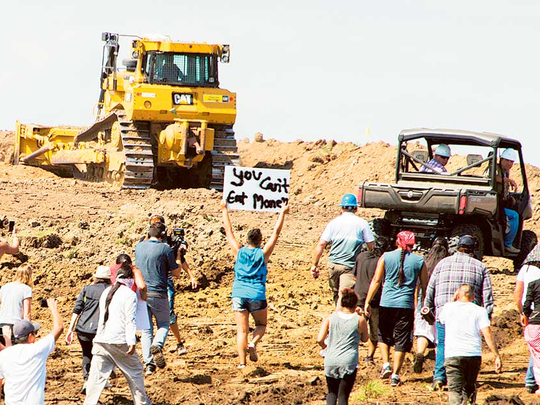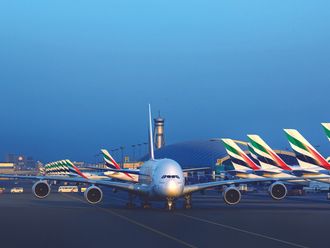
NEW YORK: With the US government siding in favour of Native American protests against a key North Dakota pipeline, local oil producers and shippers are facing the possibility of greater delays in getting a quick route to ship oil to the Gulf of Mexico.
On Friday, following ongoing protests from environmentalists and Native American tribes, the US. Justice Department asked operators of the Dakota Access pipeline to suspend construction along a 40-mile (64km) stretch in North Dakota, just minutes after a US district court said construction could resume.
The 1,100-mile (1,770km), $3.7 billion (Dh13.59 billion) Dakota Access pipeline was originally expected to start up later this year, to deliver more than 470,000 barrels per day of crude from North Dakota’s prolific Bakken shale play through Illinois and towards refinery row in the US. Gulf Coast.
Should the pipeline be delayed for a substantial period, it would affect producers who had counted on demand for oil to be rapidly shipped to the US. Gulf, as well as shippers who could find themselves stuck with crude, putting them at risk of unloading it at a loss.
The primary owner of the Dakota Access pipeline is Energy Transfer Partners. Shares of that company’s stock fell 3.6 per cent on Friday, sliding after the Justice Department’s statement.
Dakota Access LLC, a unit of ETP, declined to comment on Friday. It is unclear what the workaround will be if it is unable to build on the current route, though such reroutes can be costly. Other North American pipelines have in the past been rerouted in response to protests.
Brigham McCown, the former head of the US Pipeline and Hazardous Materials Safety Administration (PHMSA) under George W. Bush, said that reroutes can be fairly expensive, particularly if it needs to be moved substantially away from the locale of a dispute.
“It could delay a project by years. If you’re moving the pipeline to an area that’s far enough, you may need to go through the regulatory process gain and get permits like ones for water and endangered species. It takes time,” McCown said.
For the oil industry, the problems are not limited just to constructing the pipeline. Shippers with long-term contracts have already started buying the oil for delivery later this year — known as line fill — ahead of the expected start-up, according to a source familiar with pipeline operations.
Line fill refers to the amount of barrels that move through a pipeline constantly in order to maintain pressure and flow.
Trading sources estimate that line fill from North Dakota to the Gulf Coast will be some 8 million barrels altogether.
The anticipated extra demand helped boost Bakken prices {WTC-BAK} this week to a three-month high, trading at about 35 cents a barrel discount to US crude futures. A year ago, they were trading at $1.75 a barrel discount to US crude.
It was anticipated that these barrels would be moved to the Gulf through the new, swift route via Illinois — rather than the more arduous rail routes to the East and West Coasts, or through pipelines in the Rocky Mountains en route to Oklahoma and eventually Texas.
“In the absence of a new alternative, (Bakken) crude will have to use the existing infrastructure to move,” said Sandy Fielden, the director of research for commodities and energy at Morningstar.
The lack of pipeline infrastructure creates a problem for shippers. There is little commercial storage available in North Dakota, so storing large volumes is not a possibility.
Shippers may have no choice but to sell off the oil at a loss, transport it via more expensive rail routes, or move crude through already-crowded pipelines to the US storage hub of Cushing, Oklahoma.
That would hurt cash-strapped Bakken producers already dealing with the two-year global oil market rout, because of competitive prices from imports.
“Producers will have to take lower prices to compete with imports,” said Fielden.
About 1 million barrels of oil were produced daily in North Dakota in June.
The US. Justice Department, in its statement, said it will not allow construction of the pipeline on US. Army Corps of Engineers land bordering the Lake Oahe area, the site of the main protests.
While work remains uncertain in North Dakota, construction continues in all other parts of the state and in other states.
The Dakota Access pipeline is also owned by Phillips 66
and Sunoco Logistics Partners. Last month, Enbridge Inc said it had formed a joint venture with Marathon Petroleum Corp to take a minority stake in the pipeline.
— Reuters











